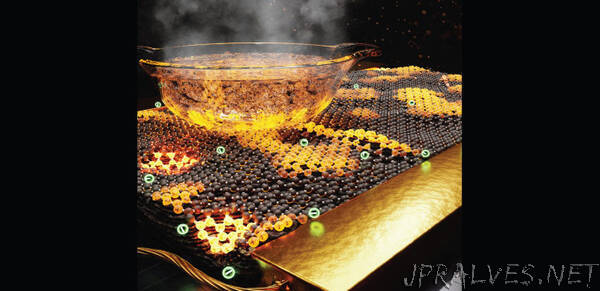
“Graphitic thin films hit high temperatures within seconds under low voltage.
Combining multiple carbon nanomaterials in a single substance can yield surprising properties. KAUST researchers have created thin graphite films that could act as high-performance flexible heater panels, reaching several hundred degrees within seconds when a small voltage is applied1. They also showed that the key to the material’s exceptional heating performance is graphene domains within the graphite film.
As outstanding thermal conductors, graphitic carbon nanomaterials are increasingly used for heat management, for example, to dissipate heat from microchips. The same materials could also be used as electric heaters.
“There’s a need to develop low-power, flexible heater panels, and nanocarbons are key contenders,” says G. Deokar, a postdoc in Pedro Costa’s lab, who led the work. “So far, however, their electrothermal performance has been limited,” she adds. Nanocarbon-based heaters commonly require an input of 20-60 volts to reach a 250 degrees Celsius target temperature. They can also degrade rapidly when heated in air.
Costa, Deokar and their colleagues recently developed a method to manufacture nanoscale-thick graphite films (NGFs) at wafer-scale2,3. They also were able to easily transfer them to arbitrary substrates, without the residues often present in graphene panels. “These characteristics of the NGF prompted us to investigate their application in thermal management technologies,” Deokar says.
When the team placed NGFs on flexible Kapton sheets and applied gold electrodes, their heater performance was found to be far superior to previously reported nanocarbon heaters. Applying less than 8 volts, the material hit a target temperature of 300 degrees Celsius within seconds. Cooling was equally rapid. “We also observed outstanding stability and showed the NGF could be used as an external reusable patch to boil water,” Deokar says.
“We operated them at double the maximum temperature of other nanocarbons (with roughly half the power input) and the useful heating area was also augmented, meaning the efficiency of the panel was considerably better,” Pedro adds.
Potential applications for the material could range from miniature heaters for sensors or microfluidic devices to industrial-scale heaters, such as aviation defoggers or space heat regulators.
The team’s working understanding is that the NGF’s excellent performance is due to the presence of graphene domains and wrinkles in the material, which act as hotspots. “These structural features are distributed all over the NGF surface, explaining the high temperatures and uniform heat spread,” Deokar says.
Although wrinkles are common features in other nanoscale-thick graphite films, the graphene domains in our NGFs are unique, Pedro adds. “The presence and function of the graphene domains is something that we want to better understand,” he says.”
